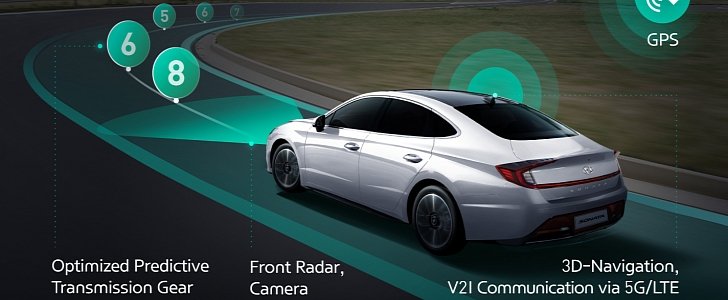Intelligent automatic transmissions are not something new in the auto industry. Coupled with a series of other systems, including artificial intelligence, gearboxes have grown incredibly advanced over the past few years. But, it seems, there is still room for improvement.
This week, South Korean carmakers Hyundai and Kia announced they are working on a new system that should allow future transmissions to change gears depending on an increased number of factors, with the goal of reducing fuel consumption.
The tech is called ICT Connected Shift System. ICT stands for Information and Communication Technology and essentially means the transmission is reading data from systems like 3D navigation, cameras, and radars to determine which is the best time to shift and how.
There are, of course, similar systems available elsewhere in the industry. Rolls Royce, for instance, launched a while back (2013) the Satellite Aided Transmission, used for the first time on the Wraith. The British system uses GPS data to anticipate what it needs to do based on location and driving style.
But that system seems a bit limited, if we are to trust what Hyundai says about the ICT.
First, the new tech supposedly will react to terrain elevation, gradient, and curvature, in addition to traffic conditions and road events.
Then, it will be able to switch the driving mode for a car. For instance, when a highway is coming up, the transmission automatically goes to Sport Mode to ease merging into traffic. It can also switch to neutral when long stops in traffic are detected.
We’re not sure how far along the two South Korean carmakers are to making this tech a reality, but some tests have already been done, and the results are encouraging.
When put through its paces on a heavily curved road, the transmission proved it could reduce the frequency of shifts during cornering by 43 percent, and as a result the frequency of brake operation dropped by 11 percent.
The Koreans plan to deploy the tech, once it's ready, should make its way on production cars. Future evolutions will allow integration of other data as well, like driver’s preferences and traffic signal status.
The tech is called ICT Connected Shift System. ICT stands for Information and Communication Technology and essentially means the transmission is reading data from systems like 3D navigation, cameras, and radars to determine which is the best time to shift and how.
There are, of course, similar systems available elsewhere in the industry. Rolls Royce, for instance, launched a while back (2013) the Satellite Aided Transmission, used for the first time on the Wraith. The British system uses GPS data to anticipate what it needs to do based on location and driving style.
But that system seems a bit limited, if we are to trust what Hyundai says about the ICT.
First, the new tech supposedly will react to terrain elevation, gradient, and curvature, in addition to traffic conditions and road events.
Then, it will be able to switch the driving mode for a car. For instance, when a highway is coming up, the transmission automatically goes to Sport Mode to ease merging into traffic. It can also switch to neutral when long stops in traffic are detected.
We’re not sure how far along the two South Korean carmakers are to making this tech a reality, but some tests have already been done, and the results are encouraging.
When put through its paces on a heavily curved road, the transmission proved it could reduce the frequency of shifts during cornering by 43 percent, and as a result the frequency of brake operation dropped by 11 percent.
The Koreans plan to deploy the tech, once it's ready, should make its way on production cars. Future evolutions will allow integration of other data as well, like driver’s preferences and traffic signal status.

